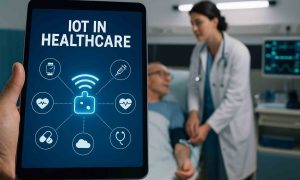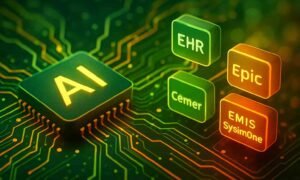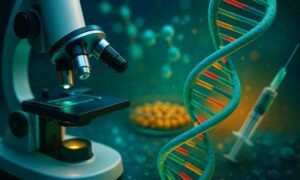

Introduction: In today’s healthcare landscape, the integration of Internet of Things (IoT) technology has ushered in a new era of patient care, revolutionizing traditional approaches with the deployment of smart devices and wearables. These innovative solutions have redefined patient monitoring, intervention, and management of chronic conditions, significantly impacting healthcare outcomes. This article delves into the transformative influence of IoT in healthcare, emphasizing the pivotal role played by smart devices and wearables in enhancing patient care and augmenting medical outcomes.
1. Remote Patient Monitoring with IoT: Remote patient monitoring (RPM) is undergoing a paradigm shift with the integration of IoT technology. Companies like Philips Healthcare provide RPM solutions that seamlessly integrate with wearable devices, facilitating real-time tracking of vital signs such as heart rate, blood pressure, and glucose levels. This continuous monitoring empowers healthcare providers to detect early signs of deterioration, intervene promptly, and mitigate adverse events. The adoption of IoT in remote patient monitoring is poised to revolutionize healthcare delivery by providing clinicians with timely data insights for proactive interventions, as highlighted by Healthcare IT News.
2. Personalized Wellness Management through IoT: IoT-enabled smart devices and wearables are empowering individuals to take charge of their health and wellness like never before. Companies like Fitbit offer wearable fitness trackers that leverage IoT capabilities to monitor physical activity, sleep quality, and overall health metrics. These devices provide users with personalized insights and recommendations, promoting preventive care and healthy lifestyle choices. According to Medical News Today, IoT-powered wearable fitness trackers are driving a revolution in preventive healthcare by encouraging individuals to adopt healthier habits and routines.
3. Predictive Analytics Revolutionizing Healthcare with IoT: The application of predictive analytics in healthcare is experiencing a renaissance with the advent of IoT technology. Companies like IBM Watson Health harness IoT sensors and AI algorithms to analyze patient data, predicting outcomes such as hospital readmissions and patient deterioration. Predictive analytics powered by IoT enable healthcare providers to anticipate patient needs, tailor interventions, and optimize resource allocation. The integration of IoT in predictive analytics holds immense potential to transform healthcare delivery by leveraging data-driven insights for informed decision-making.
4. Telemedicine’s Evolution with IoT Integration: Telemedicine has undergone a transformative evolution with the integration of IoT technology. Companies like Teladoc Health offer telehealth platforms that seamlessly integrate with wearable devices, facilitating remote consultations and monitoring. IoT-enabled telemedicine solutions empower patients to access healthcare services from the comfort of their homes, enhancing access and convenience. As highlighted by Harvard Business Review, telemedicine powered by IoT is revolutionizing healthcare delivery, offering scalable and cost-effective solutions for remote patient care.
5. Enhancing Medication Adherence with IoT Solutions: IoT technology is driving innovations in medication adherence solutions, particularly for patients with chronic conditions. Smart pill dispensers, such as those offered by PillDrill, leverage IoT sensors to track medication usage and provide timely reminders. These solutions enhance patient safety and medication management, reducing the risk of adverse events and hospitalizations. IoT-enabled medication adherence platforms offer healthcare providers insights into patient compliance, enabling personalized interventions and support for improved health outcomes.
6. Revolutionizing Surgical Procedures with IoT-enabled Robotics: The field of surgical robotics is undergoing a revolution with the integration of IoT technology. Companies like Intuitive Surgical utilize IoT sensors and AI algorithms to enhance the precision and efficiency of robotic-assisted surgeries. IoT-powered surgical robotics enable surgeons to perform minimally invasive procedures with greater accuracy and control, resulting in reduced trauma and shorter recovery times. By harnessing IoT in surgical robotics, healthcare providers can offer patients advanced treatment options while minimizing risks and complications.
7. IoT’s Role in Elderly Care: IoT-enabled smart devices and wearables are transforming elderly care by facilitating remote monitoring and support for aging populations. Companies like CarePredict offer wearable devices equipped with IoT sensors to track activities and health status. These devices detect changes in behavior and alert caregivers to potential issues, ensuring timely interventions. Additionally, IoT-enabled smart home solutions provide elderly individuals with safety features, promoting independence and aging in place comfortably.
8. Leveraging IoT for Mental Health Monitoring: IoT technology is increasingly being used for mental health monitoring, providing insights into well-being and enabling timely interventions. Companies like Oura Ring offer wearable devices that track sleep patterns and physiological signals associated with stress. These devices analyze data trends to identify patterns indicative of mental health concerns, empowering individuals to manage their conditions effectively. IoT-enabled mental health monitoring solutions offer new avenues for monitoring, intervention, and support, revolutionizing mental healthcare delivery.
9. IoT’s Impact on Rehabilitation and Physical Therapy: IoT technology is transforming rehabilitation and physical therapy with personalized, data-driven interventions. Companies like Neofect offer IoT-enabled rehabilitation solutions that use wearable devices and gamified exercises. These solutions track patient movements and progress, providing real-time feedback and motivation. IoT-enabled tele-rehabilitation platforms offer remote access to therapy sessions, increasing accessibility and enhancing recovery experiences.
10. Advancing Clinical Trials and Research with IoT Integration: IoT technology is revolutionizing clinical trials and research, enabling remote monitoring and data collection. Companies like THREAD Research offer IoT-powered platforms for virtual clinical trials. These platforms streamline the trial process and improve patient engagement, accelerating innovation in healthcare. IoT sensors embedded in medical devices enable researchers to collect real-world data, advancing scientific discovery and treatment effectiveness.
Conclusion: In conclusion, IoT technology is reshaping the landscape of healthcare, offering unprecedented opportunities to enhance patient care and outcomes. From remote patient monitoring to predictive analytics and telemedicine, IoT is revolutionizing healthcare delivery across various domains. By harnessing the power of IoT-enabled smart devices and wearables, healthcare providers can deliver personalized, data-driven care, ultimately improving patient satisfaction and quality of life.
References:
- Philips Healthcare. (n.d.). Retrieved from https://www.philips.com/healthcare
- Healthcare IT News. (2024). Remote Patient Monitoring: Improving Patient Outcomes with IoT. Retrieved from https://www.healthcareitnews.com/
- Fitbit. (n.d.). Retrieved from https://www.fitbit.com/global/us/home
- Medical News Today. (2024). Empowering Personal Wellness with IoT Devices. Retrieved from https://www.medicalnewstoday.com/
- IBM Watson Health. (n.d.). Retrieved from https://www.ibm.com/watson-health
- Teladoc Health. (n.d.). Retrieved from https://www.teladoc.com/
- Harvard Business Review. (2024). Telemedicine: Revolutionizing Healthcare Delivery with IoT. Retrieved from https://hbr.org/
- PillDrill. (n.d.). Retrieved from https://www.pilldrill.com/
- Healthcare IT News. (2024). IoT in Medication Adherence: Enhancing Patient Safety. Retrieved from https://www.healthcareitnews.com/
- Intuitive Surgical. (n.d.). Retrieved from https://www.intuitive.com/
- CarePredict. (n.d.). Retrieved from https://www.carepredict.com/
- Oura Ring. (n.d.). Retrieved from https://ouraring.com/
- Psychology Today. (2024). IoT in Mental Health Monitoring: Transforming Care Delivery. Retrieved from https://www.psychologytoday.com/
- Neofect. (n.d.). Retrieved from https://www.neofect.com/
- PT in Motion. (2024). IoT in Rehabilitation and Physical Therapy: Innovations in Patient Care. Retrieved from https://www.apta.org/ptinmotion/
- THREAD Research. (n.d.). Retrieved from https://www.threadresearch.com/





















